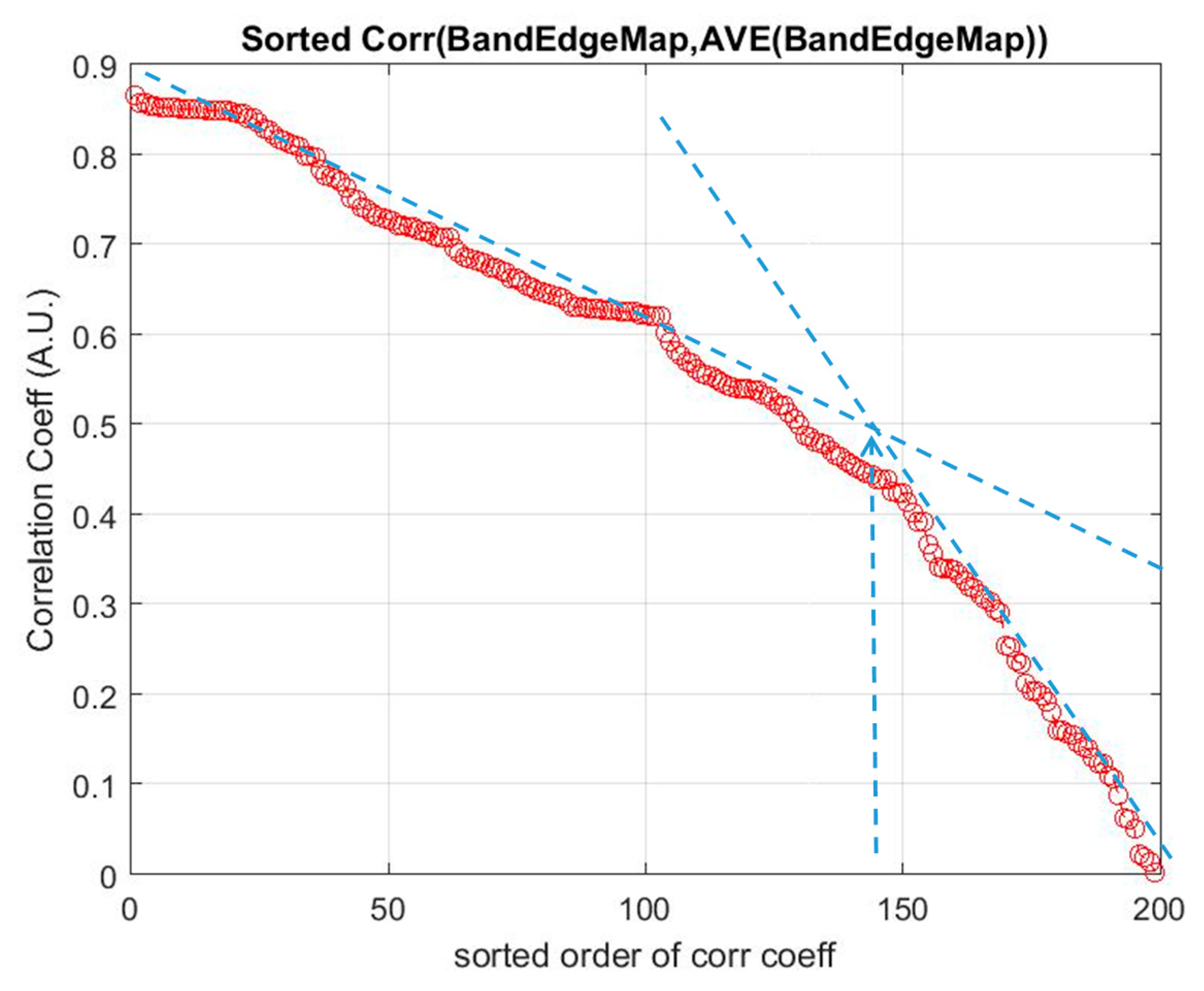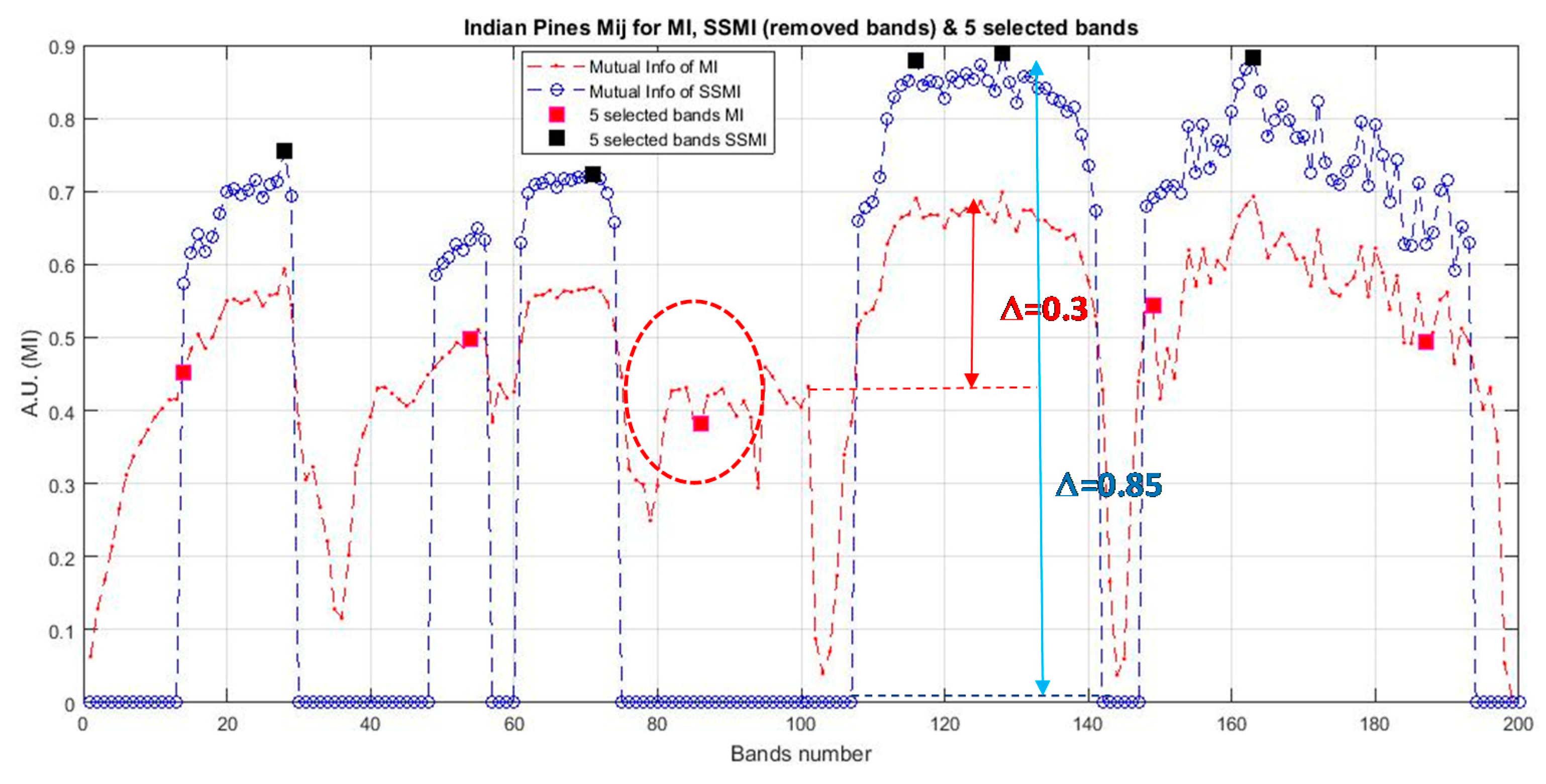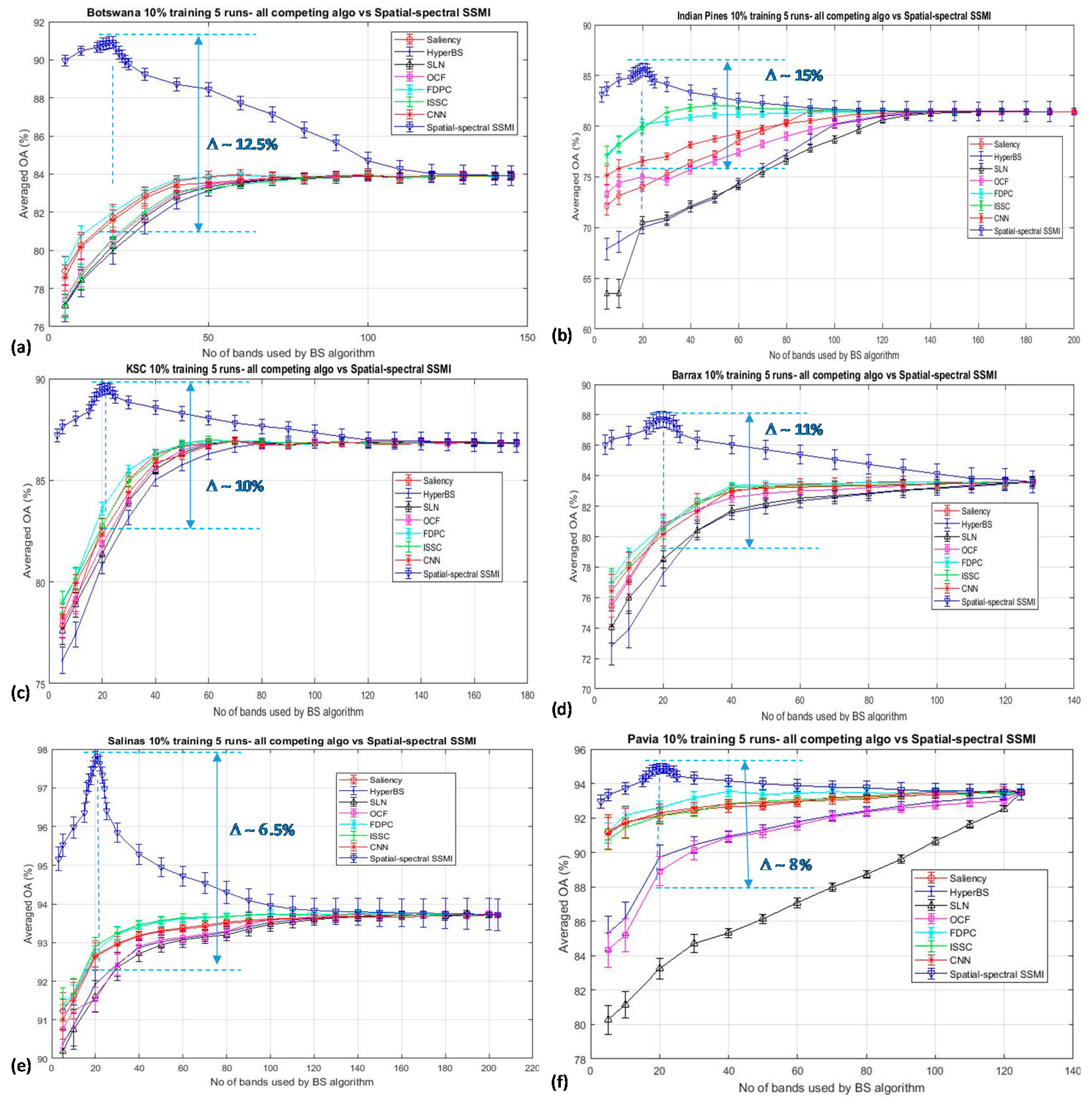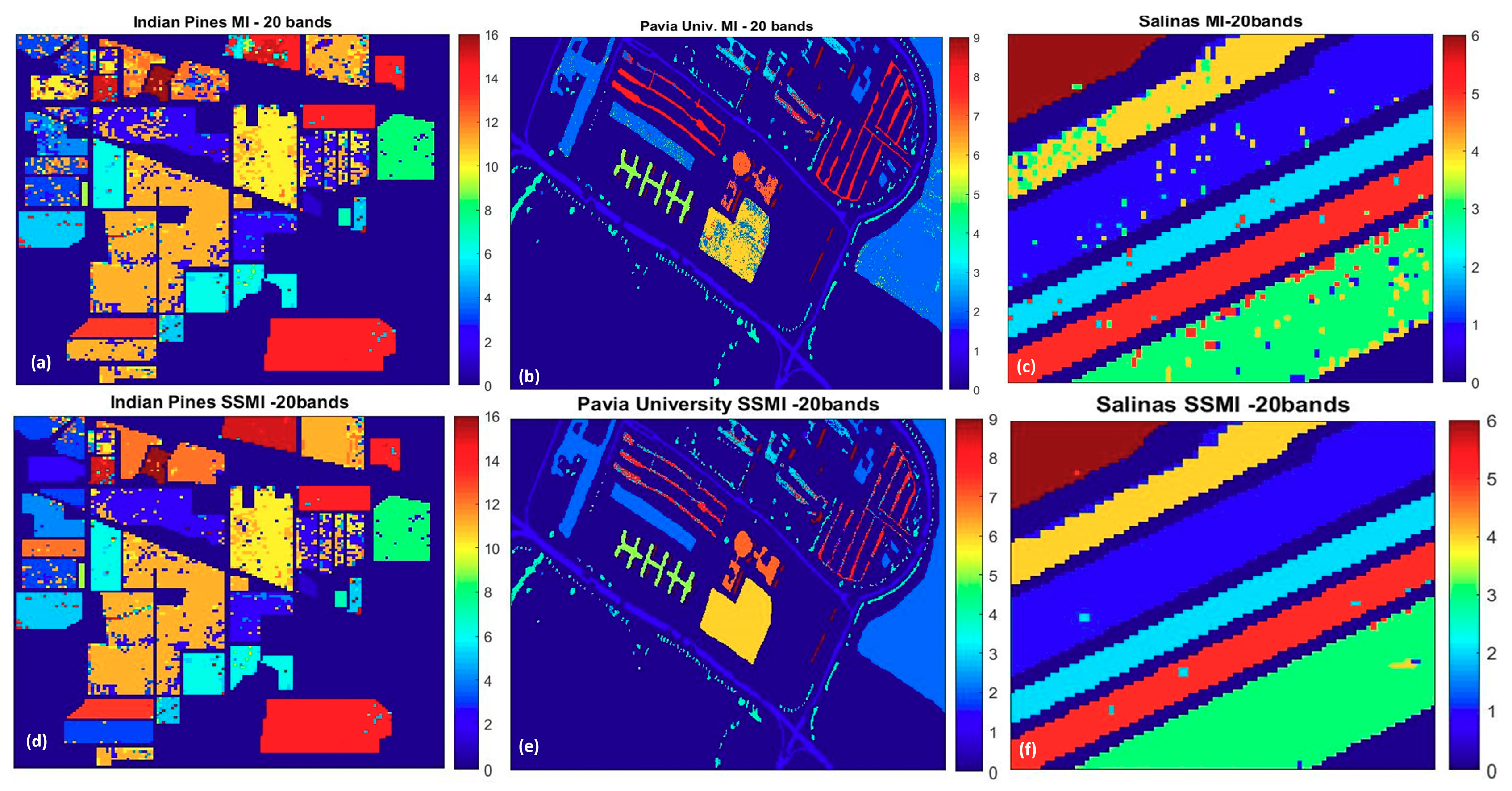Spatial Spectral Band Selection for Enhanced Hyperspectral Remote Sensing Classification Applications
Abstract
1. Introduction
2. Methods and Materials
2.1. Spatial Preprocessing Method
2.2. Spectral Band Selections Using Mutual Information (MI)
2.3. Spatial Spectral Mutual Information Band Selections (SSMI)
2.4. Competing Band Selection Algorithms
2.4.1. Saliency Bands and Scale Selection (SBSS)
2.4.2. HyperBS
2.4.3. SLN (Single-Layer Neural Networks)
2.4.4. OCF (Optimal Clustering Framework)
2.4.5. E-FDPC (Enhanced Fast Density-Peak-Based Clustering)
2.4.6. ISSC (Improved Sparse Subspace Clustering)
2.4.7. CNN (Convolutional Neural Network)
2.5. HSI Datasets Employed in This Paper
2.6. Experimental Configuration and Metrics for Assessing Classification Performances
3. Results
3.1. Band Selection (BS) Using Spectral Information Only
3.2. Band Selection (BS) Using Spatial and Spectral Information
4. Discussions
5. Conclusions
Author Contributions
Funding
Acknowledgments
Conflicts of Interest
References
- Hughes, G. On the mean accuracy of statistical pattern recognizers. IEEE Trans. Inf. Theory 1968, 14, 55–63. [Google Scholar] [CrossRef]
- Gao, F.; Wang, Q.; Dong, J.; Xu, Q. Spectral and Spatial Classification of Hyperspectral Images Based on Random Multi-Graphs. Remote Sens. 2018, 10, 1271. [Google Scholar] [CrossRef]
- Adam, E.; Mutanga, O.; Rugege, D. Multispectral and hyperspectral remote sensing for identification and mapping of wetland vegetation: a review. Wetl. Ecol. Manag. 2009, 18, 281–296. [Google Scholar] [CrossRef]
- Li, M.; Zang, S.; Zhang, B.; Li, S.; Wu, C. A Review of Remote Sensing Image Classification Techniques: The Role of Spatio-contextual Information. Eur. J. Remote Sens. 2014, 47, 389–411. [Google Scholar] [CrossRef]
- Poojary, N.; D′Souza, H.; Puttaswamy, M.; Kumar, G.H. Automatic Target Detection in Hyperspectral Image Processing: A review of Algorithms. In Proceedings of the 2015 12th International Conference on Fuzzy Systems and Knowledge Discovery (FSKD), Zhangjiajie, China, 15–17 August 2015; pp. 1991–1996. [Google Scholar]
- Manolakis, D.; Marden, D.; Shaw, G.A. Hyperspectral image processing for automatic target detection applications. Linc. Lab. J. 2003, 14, 79–116. [Google Scholar]
- Hennessy, A.; Clarke, K.; Lewis, M. Hyperspectral Classification of Plants: A Review of Waveband Selection Generalisability. Remote Sens. 2020, 12, 113. [Google Scholar] [CrossRef]
- Cheng, J.-H.; Nicolaï, B.; Sun, D.-W. Hyperspectral imaging with multivariate analysis for technological parameters prediction and classification of muscle foods: A review. Meat Sci. 2017, 123, 182–191. [Google Scholar] [CrossRef]
- Lu, G.; Fei, B. Medical hyperspectral imaging: a review. J. Biomed. Opt. 2014, 19, 10901. [Google Scholar] [CrossRef]
- Yuen, P.; Richardson, M. An introduction to hyperspectral imaging and its application for security, surveillance and target acquisition. Imaging Sci. J. 2010, 58, 241–253. [Google Scholar] [CrossRef]
- Sun, W.; Du, Q. Hyperspectral Band Selection: A Review. IEEE Geosci. Remote Sens. Mag. 2019, 7, 118–139. [Google Scholar] [CrossRef]
- Habermann, M. Band Selection in Hyperspectral Images using Artificial Neural Networks. Ph.D. Thesis, Université de Technologie de Compiègne, Compiègne, France, 27 September 2018. [Google Scholar]
- Wang, Q.; Zhang, F.; Li, X. Optimal Clustering Framework for Hyperspectral Band Selection. IEEE Trans. Geosci. Remote Sens. 2018, 56, 1–13. [Google Scholar] [CrossRef]
- Martínez-Usómartinez-Uso, A.; Pla, F.; Sotoca, J.M.; García-Sevilla, P. Clustering-Based Hyperspectral Band Selection Using Information Measures. IEEE Trans. Geosci. Remote Sens. 2007, 45, 4158–4171. [Google Scholar] [CrossRef]
- Zhong, P.; Zhang, P.; Wang, R. Dynamic Learning of SMLR for Feature Selection and Classification of Hyperspectral Data. IEEE Geosci. Remote Sens. Lett. 2008, 5, 280–284. [Google Scholar] [CrossRef]
- Khodr, J.; Younes, R.; Khoder, J. Dimensionality Reduction on Hyperspectral Images: A Comparative Review Based on Artificial Datas. In Proceedings of the 2011 4th International Congress on Image and Signal Processing, Shanghai, China, 15–17 October 2011; Volume 4, pp. 1875–1883. [Google Scholar]
- Guo, B.; Gunn, S.R.; Damper, R.I.; Nelson, J.D.B. Band Selection for Hyperspectral Image Classification Using Mutual Information. IEEE Geosci. Remote Sens. Lett. 2006, 3, 522–526. [Google Scholar] [CrossRef]
- Estévez, P.A.; Tesmer, M.; Perez, C.A.; Zurada, J.M. Normalized Mutual Information Feature Selection. IEEE Trans. Neural Networks 2009, 20, 189–201. [Google Scholar] [CrossRef]
- Liu, H.; Sun, J.; Liu, L.; Zhang, H. Feature selection with dynamic mutual information. Pattern Recognit. 2009, 42, 1330–1339. [Google Scholar] [CrossRef]
- Fleuret, F. Fast binary feature selection with conditional mutual information. J. Mach. Learn. Res. 2004, 5, 1531–1555. [Google Scholar]
- Feng, J.; Jiao, L.C.; Zhang, X.; Sun, T. Hyperspectral Band Selection Based on Trivariate Mutual Information and Clonal Selection. IEEE Trans. Geosci. Remote Sens. 2014, 52, 4092–4105. [Google Scholar] [CrossRef]
- Guo, B.; Gunn, S.; Damper, B.; Nelson, J. Adaptive Band Selection for Hyperspectral Image Fusion using Mutual Information. In Proceedings of the 2005 7th International Conference on Information Fusion, Philadelphia, PA, USA, 25–28 July 2005; Volume 1, p. 8. [Google Scholar]
- Gunduz, A.; Principe, J.C. Correntropy as a novel measure for nonlinearity tests. Signal Process. 2009, 89, 14–23. [Google Scholar] [CrossRef]
- Liu, Y.; Chen, Y.; Tan, K.; Xie, H.; Wang, L.; Yan, X.; Xie, W.; Xu, Z. Maximum relevance, minimum redundancy band selection based on neighborhood rough set for hyperspectral data classification. Meas. Sci. Technol. 2016, 27, 125501. [Google Scholar] [CrossRef]
- Tschannerl, J.; Ren, J.; Yuen, P.; Sun, G.; Zhao, H.; Yang, Z.; Wang, Z.; Marshall, S. MIMR-DGSA: Unsupervised hyperspectral band selection based on information theory and a modified discrete gravitational search algorithm. Inf. Fusion 2019, 51, 189–200. [Google Scholar] [CrossRef]
- Feng, J.; Jiao, L.; Liu, F.; Sun, T.; Zhang, X. Mutual-Information-Based Semi-Supervised Hyperspectral Band Selection with High Discrimination, High Information, and Low Redundancy. IEEE Trans. Geosci. Remote Sens. 2015, 53, 2956–2969. [Google Scholar] [CrossRef]
- Jin, J.; Wang, Q. Selection of Informative Spectral Bands for PLS Models to Estimate Foliar Chlorophyll Content Using Hyperspectral Reflectance. IEEE Trans. Geosci. Remote Sens. 2018, 57, 3064–3072. [Google Scholar] [CrossRef]
- Amankwah, A. Spatial Mutual Information Based Hyperspectral Band Selection for Classification. Sci. World J. 2015, 2015, 1–7. [Google Scholar] [CrossRef] [PubMed]
- Zhu, G.; Huang, Y.; Lei, J.; Bi, Z.; Xu, F. Unsupervised Hyperspectral Band Selection by Dominant Set Extraction. IEEE Trans. Geosci. Remote Sens. 2015, 54, 227–239. [Google Scholar] [CrossRef]
- Sun, W.; Zhang, L.; Zhang, L.; Lai, Y.M. A Dissimilarity-Weighted Sparse Self-Representation Method for Band Selection in Hyperspectral Imagery Classification. IEEE J. Sel. Top. Appl. Earth Obs. Remote Sens. 2016, 9, 4374–4388. [Google Scholar] [CrossRef]
- Sun, W.; Jiang, M.; Li, W.; Liu, Y.-N. A Symmetric Sparse Representation Based Band Selection Method for Hyperspectral Imagery Classification. Remote Sens. 2016, 8, 238. [Google Scholar] [CrossRef]
- Sun, W.; Zhang, L.; Du, B.; Li, W.; Lai, Y.M. Band Selection Using Improved Sparse Subspace Clustering for Hyperspectral Imagery Classification. IEEE J. Sel. Top. Appl. Earth Obs. Remote Sens. 2015, 8, 2784–2797. [Google Scholar] [CrossRef]
- Sun, W.; Li, W.; Li, J.; Lai, Y.M. Band selection using sparse nonnegative matrix factorization with the thresholded Earth’s mover distance for hyperspectral imagery classification. Earth Sci. Informatics 2015, 8, 907–918. [Google Scholar] [CrossRef]
- Chang, C.-I.; Liu, K.-H. Progressive Band Selection of Spectral Unmixing for Hyperspectral Imagery. IEEE Trans. Geosci. Remote Sens. 2014, 52, 2002–2017. [Google Scholar] [CrossRef]
- Yang, C.; Bruzzone, L.; Zhao, H.; Tan, Y.; Guan, R. Superpixel-Based Unsupervised Band Selection for Classification of Hyperspectral Images. IEEE Trans. Geosci. Remote Sens. 2018, 56, 7230–7245. [Google Scholar] [CrossRef]
- Geng, X.; Sun, K.; Ji, L.; Zhao, Y. A Fast Volume-Gradient-Based Band Selection Method for Hyperspectral Image. IEEE Trans. Geosci. Remote Sens. 2014, 52, 7111–7119. [Google Scholar] [CrossRef]
- Zhang, W.; Li, X.; Dou, Y.; Zhao, L. A Geometry-Based Band Selection Approach for Hyperspectral Image Analysis. IEEE Trans. Geosci. Remote Sens. 2018, 56, 4318–4333. [Google Scholar] [CrossRef]
- Asl, M.G.; Mobasheri, M.R.; Mojaradi, B. Unsupervised Feature Selection Using Geometrical Measures in Prototype Space for Hyperspectral Imagery. IEEE Trans. Geosci. Remote Sens. 2013, 52, 3774–3787. [Google Scholar] [CrossRef]
- Jones, M.C.; Sibson, R. What is Projection Pursuit? J. R. Stat. Soc. Ser. A 1987, 150, 1. [Google Scholar] [CrossRef]
- Chang, C.-I.; Ifarraguerri, A. Unsupervised hyperspectral image analysis with projection pursuit. IEEE Trans. Geosci. Remote Sens. 2000, 38, 2529–2538. [Google Scholar] [CrossRef]
- Kaewpijit, S.; Moigne, J.L.; El-Ghazawi, T. Hyperspectral Imagery Dimension Reduction using Principal Component Analysis on the HIVE. In Proceedings of the Science Data Processing Workshop, Greenbelt, MD, USA, 28 February 2002. [Google Scholar]
- Agarwal, A.; El-Ghazawi, T.; El-Askary, H.; Le-Moigne, J. Efficient Hierarchical-PCA Dimension Reduction for Hyperspectral Imagery. In Proceedings of the 2007 IEEE International Symposium on Signal Processing and Information Technology, Giza, Egypt, 15–18 December 2007; pp. 353–356. [Google Scholar] [CrossRef]
- Fauvel, M.; Chanussot, J.; Benediktsson, J.A. Kernel Principal Component Analysis for the Classification of Hyperspectral Remote Sensing Data over Urban Areas. EURASIP J. Adv. Signal Process. 2009, 2009, 1–15. [Google Scholar] [CrossRef]
- Wang, J.; Chang, C.-I. Independent component analysis-based dimensionality reduction with applications in hyperspectral image analysis. IEEE Trans. Geosci. Remote Sens. 2006, 44, 1586–1600. [Google Scholar] [CrossRef]
- Chang, C.-I.; Wang, S. Constrained band selection for hyperspectral imagery. IEEE Trans. Geosci. Remote Sens. 2006, 44, 1575–1585. [Google Scholar] [CrossRef]
- Koonsanit, K.; Jaruskulchai, C.; Eiumnoh, A. Band Selection for Dimension Reduction in Hyper Spectral Image Using Integrated InformationGain and Principal Components Analysis Technique. Int. J. Mach. Learn. Comput. 2012, 2, 248–251. [Google Scholar] [CrossRef]
- Menon, V.; Du, Q.; Fowler, J.E. Fast SVD With Random Hadamard Projection for Hyperspectral Dimensionality Reduction. IEEE Geosci. Remote Sens. Lett. 2016, 13, 1275–1279. [Google Scholar] [CrossRef]
- Yuan, Y.; Zhu, G.; Wang, Q. Hyperspectral Band Selection by Multitask Sparsity Pursuit. IEEE Trans. Geosci. Remote Sens. 2015, 53, 631–644. [Google Scholar] [CrossRef]
- Damodaran, B.B.; Courty, N.; Lefevre, S. Sparse Hilbert Schmidt Independence Criterion and Surrogate-Kernel-Based Feature Selection for Hyperspectral Image Classification. IEEE Trans. Geosci. Remote Sens. 2017, 55, 2385–2398. [Google Scholar] [CrossRef]
- Li, X.; Zhang, L.; You, J. Hyperspectral Image Classification Based on Two-Stage Subspace Projection. Remote Sens. 2018, 10, 1565. [Google Scholar] [CrossRef]
- Liu, G.; Yan, S. Latent Low-Rank Representation for Subspace Segmentation and Feature Extraction. In Proceedings of the 2011 International Conference on Computer Vision, Barcelona, Spain, 6–13 November 2011; Volume 6, pp. 1615–1622. [Google Scholar]
- Lin, Z.; Chen, M.; Ma, Y. The augmented lagrange multiplier method for exact recovery of corrupted low-rank matrices. arXiv 2010, arXiv:1009.5055. Available online: https://arxiv.org/pdf/1009.5055 (accessed on 21 June 2020).
- Cao, X.; Wu, B.; Tao, D.; Jiao, L. Automatic Band Selection Using Spatial-Structure Information and Classifier-Based Clustering. IEEE J. Sel. Top. Appl. Earth Obs. Remote Sens. 2016, 9, 4352–4360. [Google Scholar] [CrossRef]
- Zheng, X.; Yuan, Y.; Lu, X. Dimensionality Reduction by Spatial–Spectral Preservation in Selected Bands. IEEE Trans. Geosci. Remote Sens. 2017, 55, 5185–5197. [Google Scholar] [CrossRef]
- Wei, X.; Zhu, W.; Liao, B.; Cai, L. Matrix-Based Margin-Maximization Band Selection with Data-Driven Diversity for Hyperspectral Image Classification. IEEE Trans. Geosci. Remote Sens. 2018, 56, 7294–7309. [Google Scholar] [CrossRef]
- Qian, Y.; Yao, F.; Jia, S. Band selection for hyperspectral imagery using affinity propagation. IET Comput. Vis. 2009, 3, 213–222. [Google Scholar] [CrossRef]
- Su, H.; Yang, H.; Du, Q.; Sheng, Y. Semisupervised Band Clustering for Dimensionality Reduction of Hyperspectral Imagery. IEEE Geosci. Remote Sens. Lett. 2011, 8, 1135–1139. [Google Scholar] [CrossRef]
- Datta, A.; Ghosh, S.; Ghosh, A. Combination of Clustering and Ranking Techniques for Unsupervised Band Selection of Hyperspectral Images. IEEE J. Sel. Top. Appl. Earth Obs. Remote Sens. 2015, 8, 1–10. [Google Scholar] [CrossRef]
- Zhai, H.; Zhang, H.; Zhang, L.; Li, P. Laplacian-Regularized Low-Rank Subspace Clustering for Hyperspectral Image Band Selection. IEEE Trans. Geosci. Remote Sens. 2019, 57, 1723–1740. [Google Scholar] [CrossRef]
- Yu, C.; Wang, Y.; Song, M.; Chang, C.-I. Class Signature-Constrained Background- Suppressed Approach to Band Selection for Classification of Hyperspectral Images. IEEE Trans. Geosci. Remote Sens. 2019, 57, 14–31. [Google Scholar] [CrossRef]
- Jia, S.; Tang, G.; Zhu, J.; Li, Q. A Novel Ranking-Based Clustering Approach for Hyperspectral Band Selection. IEEE Trans. Geosci. Remote Sens. 2015, 54, 88–102. [Google Scholar] [CrossRef]
- Yuan, Y.; Lin, J.; Wang, Q. Dual-Clustering-Based Hyperspectral Band Selection by Contextual Analysis. IEEE Trans. Geosci. Remote Sens. 2015, 54, 1431–1445. [Google Scholar] [CrossRef]
- Sun, W.; Peng, J.; Yang, G.; Du, Q. Fast and Latent Low-Rank Subspace Clustering for Hyperspectral Band Selection. IEEE Trans. Geosci. Remote Sens. 2020, 58, 3906–3915. [Google Scholar] [CrossRef]
- Feng, J.; Jiao, L.; Sun, T.; Liu, H.; Zhang, X. Multiple Kernel Learning Based on Discriminative Kernel Clustering for Hyperspectral Band Selection. IEEE Trans. Geosci. Remote Sens. 2016, 54, 6516–6530. [Google Scholar] [CrossRef]
- Shi, A.; Gao, H.; He, Z.; Li, M.; Xu, L. A Hyperspectral Band Selection Based on Game Theory and Differential Evolution Algorithm. Int. J. Smart Sens. Intell. Syst. 2016, 9, 1971–1990. [Google Scholar] [CrossRef]
- Lorenzo, P.R.; Tulczyjew, L.; Marcinkiewicz, M.; Nalepa, J. Hyperspectral Band Selection Using Attention-Based Convolutional Neural Networks. IEEE Access 2020, 8, 42384–42403. [Google Scholar] [CrossRef]
- Ma, X.; Fu, A.; Wang, J.; Wang, H.; Yin, B. Hyperspectral Image Classification Based on Deep Deconvolution Network with Skip Architecture. IEEE Trans. Geosci. Remote Sens. 2018, 56, 4781–4791. [Google Scholar] [CrossRef]
- Wei, X.; Cai, L.; Liao, B.; Lu, T. Local-View-Assisted Discriminative Band Selection with Hypergraph Autolearning for Hyperspectral Image Classification. IEEE Trans. Geosci. Remote Sens. 2020, 58, 2042–2055. [Google Scholar] [CrossRef]
- Wei, X.; Zhu, W.; Liao, B.; Cai, L. Scalable One-Pass Self-Representation Learning for Hyperspectral Band Selection. IEEE Trans. Geosci. Remote Sens. 2019, 57, 4360–4374. [Google Scholar] [CrossRef]
- Gong, M.; Zhang, M.; Yuan, Y. Unsupervised Band Selection Based on Evolutionary Multiobjective Optimization for Hyperspectral Images. IEEE Trans. Geosci. Remote Sens. 2016, 54, 544–557. [Google Scholar] [CrossRef]
- Fauvel, M.; Dechesne, C.; Zullo, A.; Ferraty, F. Fast Forward Feature Selection of Hyperspectral Images for Classification with Gaussian Mixture Models. IEEE J. Sel. Top. Appl. Earth Obs. Remote Sens. 2015, 8, 2824–2831. [Google Scholar] [CrossRef]
- Patra, S.; Modi, P.; Bruzzone, L. Hyperspectral Band Selection Based on Rough Set. IEEE Trans. Geosci. Remote Sens. 2015, 53, 5495–5503. [Google Scholar] [CrossRef]
- Pan, B.; Shi, Z.; Xu, X. Analysis for the Weakly Pareto Optimum in Multiobjective-Based Hyperspectral Band Selection. IEEE Trans. Geosci. Remote Sens. 2019, 57, 3729–3740. [Google Scholar] [CrossRef]
- Sun, W.; Du, Q. Graph-Regularized Fast and Robust Principal Component Analysis for Hyperspectral Band Selection. IEEE Trans. Geosci. Remote Sens. 2018, 56, 3185–3195. [Google Scholar] [CrossRef]
- Wang, Y.; Wang, L.; Xie, H.; Chang, C.-I. Fusion of Various Band Selection Methods for Hyperspectral Imagery. Remote Sens. 2019, 11, 2125. [Google Scholar] [CrossRef]
- Benabadji, S.I.; Karoui, M.S.; Djerriri, K.; Boukerch, I.; Farhi, N.; Bouhlala, M.A. Unsupervised hyperspectral band selection by combination of unmixing and sequential clustering techniques. Eur. J. Remote Sens. 2018, 52, 30–39. [Google Scholar] [CrossRef]
- Yang, H.; Du, Q.; Su, H.; Sheng, Y. An Efficient Method for Supervised Hyperspectral Band Selection. IEEE Geosci. Remote Sens. Lett. 2010, 8, 138–142. [Google Scholar] [CrossRef]
- Riedmann, M.; Milton, E.J. Supervised Band Selection for Optimal use of Data from Airborne Hyperspectral Sensors. In Proceedings of the IGARSS 2003 IEEE International Geoscience and Remote Sensing Symposium, Toulouse, France, 21–25 July 2004; Volume 3, pp. 1770–1772. [Google Scholar]
- Yu, C.; Lee, L.-C.; Chang, C.-I.; Xue, B.; Song, M.; Chen, J. Band-Specified Virtual Dimensionality for Band Selection: An Orthogonal Subspace Projection Approach. IEEE Trans. Geosci. Remote Sens. 2018, 56, 2822–2832. [Google Scholar] [CrossRef]
- Sun, W.; Tian, L.; Xu, Y.; Zhang, D.; Du, Q. Fast and Robust Self-Representation Method for Hyperspectral Band Selection. IEEE J. Sel. Top. Appl. Earth Obs. Remote Sens. 2017, 10, 5087–5097. [Google Scholar] [CrossRef]
- Shannon, C.E. A Mathematical Theory of Communication. Bell Syst. Tech. J. 1948, 27, 379–423. [Google Scholar] [CrossRef]
- Ren, J.; Kelman, T.; Marshall, S. Adaptive Clustering of Spectral Components for Band Selection in Hyperspectral Imagery. In Proceedings of the Hyperspectral Imaging Conference 2011, Glasgow, UK, 16–18 May 2011. [Google Scholar]
- Lin, L.; Zhang, S. Superpixel Segmentation of Hyperspectral Images Based on Entropy and Mutual Information. Appl. Sci. 2020, 10, 1261. [Google Scholar] [CrossRef]
- Varade, D.; Maurya, A.; Dikshit, O. Unsupervised band selection of hyperspectral data based on mutual information derived from weighted cluster entropy for snow classification. Geocarto Int. 2019, 1–23. [Google Scholar] [CrossRef]
- Qv, H.; Yin, J.; Luo, X.; Jia, X. Band Dual Density Discrimination Analysis for Hyperspectral Image Classification. IEEE Trans. Geosci. Remote Sens. 2018, 56, 7257–7271. [Google Scholar] [CrossRef]
- Su, P.; Liu, D.; Li, X.; Liu, Z. A Saliency-Based Band Selection Approach for Hyperspectral Imagery Inspired by Scale Selection. IEEE Geosci. Remote Sens. Lett. 2018, 15, 572–576. [Google Scholar] [CrossRef]
- Rashwan, S.; Dobigeon, N. A Split-and-Merge Approach for Hyperspectral Band Selection. IEEE Geosci. Remote Sens. Lett. 2017, 14, 1378–1382. [Google Scholar] [CrossRef]
- Shi, H.; Shen, Y.; Liu, Z. Hyperspectral bands reduction based on rough sets and fuzzy C-means clustering. In Proceedings of the 20th IEEE Instrumentation Technology Conference (Cat. No.03CH37412), Vail, CO, USA, 20–22 May 2004; pp. 1053–1056. [Google Scholar]
- Habermann, M.; Frémont, V.; Shiguemori, E.H. Supervised band selection in hyperspectral images using single-layer neural networks. Int. J. Remote Sens. 2018, 40, 3900–3926. [Google Scholar] [CrossRef]
- Sharma, V.; Diba, A.; Tuytelaars, T.; Van Gool, L. Hyperspectral CNN for Image Classification & Band Selection, with Application to face Recognition. Technical Report KUL/ESAT/PSI/1604, KU Leuven, ESAT, Leuven, Belgium. December 2016. Available online: https://lirias.kuleuven.be/retrieve/427492 (accessed on 22 April 2020).
- Hyperspectral Remote Sensing Scenes. Available online: http://www.ehu.eus/ccwintco/index.php/Hyperspectral_Remote_Sensing_Scenes (accessed on 22 April 2020).
- Spectra Barrax Campaign (SPARC). Overview and First Results from CHRIS Data. Available online: http://earth.esa.int/workshops/chris_proba_04/pres/10_JMo.pdf (accessed on 22 April 2020).
- Validation of Land European Remote Sensing Instruments. Available online: http://w3.avignon.inra.fr/valeri/ (accessed on 22 April 2020).
- Boukhechba, K.; Wu, H.; Bazine, R. DCT-Based Preprocessing Approach for ICA in Hyperspectral Data Analysis. Sensors 2018, 18, 1138. [Google Scholar] [CrossRef]
- Preet, P.; Batra, S.S.; Jayadeva. Feature Selection for Classification of Hyperspectral Data by Minimizing a Tight Bound on the VC Dimension. arXiv 2015, arXiv:1509.08112. Available online: https://arxiv.org/pdf/1509.08112 (accessed on 22 April 2020).











| Algorithm 1: Spatial Spectral Mutual Information (SSMI) |
| Input: Im = (x,y,B), threshold; Output: MI |
| % In Matlab format % |
| %% Spatial preprocessing %% |
| B = (B1…BN) |
| E = Edge (Im(Bi ,… ,BN)) |
| mE = mean(E) |
| Ci = Corr(E,mE) |
| CiRank = sort(Ci,’descent’) |
| %either manual or automatic threshold |
| CiSelect = CiRank(1:threshold) |
| %% Spectral band selection |
| ImSpec = Im(x,y,CiSelect) |
| S = size(CiSelect) |
| % Joint entropy evaluation |
| For i = 1: S |
| %choose adjacent image pair |
| Impair(i) = [ImSpec(:,:,i),ImSpec(:,:,i+1)] %normalise joint histogram |
| H(i) = Impair(i)/sum(sum(Impair(i))) |
| %joint entropy |
| JE(i) = −sum(H(i).*(log2(H(i)))); |
| MI(i) = (entropy(Im(:,:,i))+entropy(Im(:,:,i+1)) − JE(i))/JE(i) |
| end |
| Class | Pavia University | Indian Pines | Barrax | Salinas | KSC | Botswana | ||||||
|---|---|---|---|---|---|---|---|---|---|---|---|---|
| Class Label | Number of Samples | Class Label | Number of Samples | Class Label | Number of Samples | Class Label | Number of Samples | Class Label | Number of Samples | Class Label | Number of Samples | |
| 1 | Asphalt | 6631 | Alfalfa | 46 | Alfalfa | 20606 | Brocoli Green weeds_1 | 391 | Scrub | 875 | Water | 270 |
| 2 | Meadows | 18649 | Corn-not ill | 1428 | Corn (two leaves) | 13839 | Corn_senesced green_weeds | 1343 | Willow swamp | 279 | Hippo grass | 101 |
| 3 | Gravel | 2099 | Corn mint ill | 830 | Corn (five leaves) | 4921 | Lettuce_romaine 4wk | 616 | Cabbage palm hammock | 294 | Floodplain grasses 1 | 251 |
| 4 | Trees | 3064 | Corn | 237 | Corn (six leaves) | 2063 | Lettuce_romaine 5wk | 1525 | Cabbage palm/oak hammock | 290 | Floodplain grasses 2 | 215 |
| 5 | Painted metal sheets | 1345 | Grass-pasture | 483 | Beet | 5496 | Lettuce_romaine 6wk | 674 | Slash pine | 185 | Reeds 1 | 269 |
| 6 | Bare soil | 5029 | Grass-trees | 730 | Legumes | 298 | Lettuce_romaine 7wk | 799 | Oak/broad leaf hammock | 263 | Riparian | 269 |
| 7 | Bitumen | 1330 | Grass-pasture-mowed | 28 | Wheat | 11554 | Hardwood swamp | 121 | Fire scar 2 | 259 | ||
| 8 | Self-blocking bricks | 3682 | Hay-windrowed | 478 | Experimental plots (legumes) | 4965 | Graminoid marsh | 496 | Island interior | 203 | ||
| 9 | Shadows | 947 | Oats | 20 | Experimental plots (papaver) | 5118 | Spartina marsh | 598 | Acacia woodlands | 314 | ||
| 10 | Soybean-not ill | 972 | Lignose | 1972 | Cattail marsh | 465 | Acacia shrublands | 248 | ||||
| 11 | Soybean mint ill | 2455 | Vineyard | 949 | Salt marsh | 482 | Acacia grasslands | 305 | ||||
| 12 | Soybean-clean | 593 | Test plots | 3245 | Mud flats | 578 | Short mopane | 181 | ||||
| 13 | Wheat | 205 | Lysimeter station | 534 | Water | 1066 | Mixed mopane | 268 | ||||
| 14 | Woods | 1265 | Water body site | 62 | Exposed soils | 95 | ||||||
| 15 | Buildings-Grass-Trees-Drives | 386 | Non-irrigated barley | 26132 | ||||||||
| 16 | Stone-Steel-Towers | 93 | Irrigated barley | 976 | ||||||||
| 17 | Bare soil | 11357 | ||||||||||
| 18 | Ploughed soil | 1196 | ||||||||||
© 2020 by the authors. Licensee MDPI, Basel, Switzerland. This article is an open access article distributed under the terms and conditions of the Creative Commons Attribution (CC BY) license (http://creativecommons.org/licenses/by/4.0/).
Share and Cite
Torres, R.M.; Yuen, P.W.T.; Yuan, C.; Piper, J.; McCullough, C.; Godfree, P. Spatial Spectral Band Selection for Enhanced Hyperspectral Remote Sensing Classification Applications. J. Imaging 2020, 6, 87. https://doi.org/10.3390/jimaging6090087
Torres RM, Yuen PWT, Yuan C, Piper J, McCullough C, Godfree P. Spatial Spectral Band Selection for Enhanced Hyperspectral Remote Sensing Classification Applications. Journal of Imaging. 2020; 6(9):87. https://doi.org/10.3390/jimaging6090087
Chicago/Turabian StyleTorres, Ruben Moya, Peter W.T. Yuen, Changfeng Yuan, Johathan Piper, Chris McCullough, and Peter Godfree. 2020. "Spatial Spectral Band Selection for Enhanced Hyperspectral Remote Sensing Classification Applications" Journal of Imaging 6, no. 9: 87. https://doi.org/10.3390/jimaging6090087
APA StyleTorres, R. M., Yuen, P. W. T., Yuan, C., Piper, J., McCullough, C., & Godfree, P. (2020). Spatial Spectral Band Selection for Enhanced Hyperspectral Remote Sensing Classification Applications. Journal of Imaging, 6(9), 87. https://doi.org/10.3390/jimaging6090087





